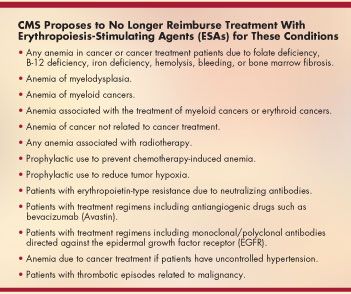Medicare Reacts to Recent Scrutiny of ESAs
The Centers for Medicare & Medicaid Services (CMS) has reacted to an FDA "Black Box Warning" for erythropoiesis-stimulating agents (ESAs), manufactured by Amgen (Ara-nesp and Epogen) and Johnson & Johnson (Procrit) by proposing a national coverage decision (NCD) that would put limits on the dose and duration of therapy in patients with cancer and related neoplastic conditions.
BALTIMOREThe Centers for Medicare & Medicaid Services (CMS) has reacted to an FDA "Black Box Warning" for erythropoiesis-stimulating agents (ESAs), manufactured by Amgen (Ara-nesp and Epogen) and Johnson & Johnson (Procrit) by proposing a national coverage decision (NCD) that would put limits on the dose and duration of therapy in patients with cancer and related neoplastic conditions. This initiative was set in motion by a preponderance of emerging data linking anemia drugs with increased risk of cardiovascular disease and tumor growth. [See also report of the ODAC meeting on ESAs on page 1.]
The proposal is subject to a 30-day public comment period ending June 13, and would be finalized 60 days afterward.
CMS issued the proposed NCD because it believes that use of ESAs for the treatment of anemia in certain oncology-related conditions is not reasonable and necessary (see Table on page 44), either because the ESA could cause a deleterious effect on the underlying disease or because the underlying cancer could increase the risk of adverse events related to use of ESAs.
Medicare currently spends more on ESAs than on any other class of drugs. Combined sales of the drugs topped $10 billion last year. As a result of the proposed coverage decision, CMS estimates reimbursement for anemia drugs could fall by as much as 10%.

Although the agency is reacting to avert potential harm caused by these widely prescribed agents, CMS also recognizes that anemia drugs are "reasonable and necessary" in oncology in certain indications.
Accordingly, CMS is proposing to allow payment in a list of cancers in which evidence exists to support the use of ESAs, ie, the presence of erythropoietin receptors on either normal tissue/cell lines or malignant tissue/cell lines. Those cancers include but are not limited to bone (sarcoma), brain-neurologic, breast, cervical, colorectal, gastric, head-and-neck (squamous cell), hepatic, lung, melanoma, multiple myeloma, muscle (including cardiac), ovarian, pancreatic (exocrine), prostate, retinal, and uterine.
However, the proposal includes certain limitations on the use of ESAs in these cancers.
• Hemoglobin levels for the month must be below 9 g/dL immediately prior to starting treatment in patients without known cardiovascular disease. They must be below 10 g/dL in patients with symptomatic ischemic disease that cannot be treated with blood transfusions.
• The maximum covered treatment duration is 12 weeks per year.
• The maximum covered 4-week treatment dose is 126,000 units for epoetin alfa and 630 g for darbepoetin alfa.
The Medicare proposal also states that continued use of an ESA is not reasonable and necessary in the following situations:
• If there is evidence of poor drug response, ie, hemoglobin rise less than 1 g/dL after 4 weeks of treatment.
• If there is an increase in fluid retention or weight (5 kg) after 2 weeks of treatment.
• If there is a rapid rise in hemoglobin level greater than 1 g/dL after 2 weeks of treatment.
Oncology Peer Review On-The-Go: Cancer-Related Fatigue Outcome Measures in Integrative Oncology
September 20th 2022Authors Dori Beeler, PhD; Shelley Wang, MD, MPH; and Viraj A. Master, MD, PhD, spoke with CancerNetwork® about a review article on cancer-related fatigue published in the journal ONCOLOGY®.